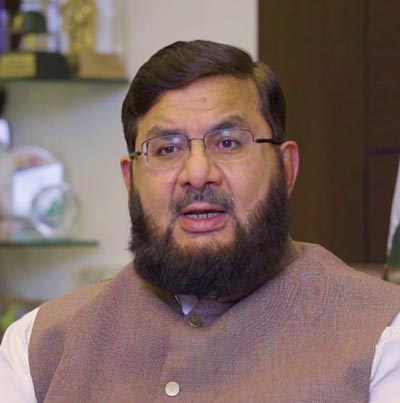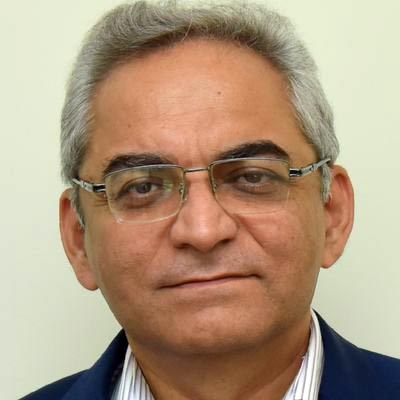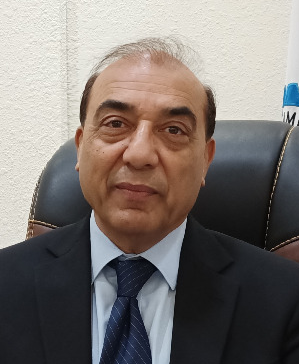Despite the improvement in Pakistan’s economic indicators, the State Bank of Pakistan, under its controversial governor, Reza Baqir, has greatly undermined the progress made in the past year by depreciating the Rupee. With costs of living for the ordinary man rising by the day and a precarious balance of payments situation, Narratives asked three leading businessmen — Aqeel Karim Dhedhi, Asad Ali Shah and Shariq Vohra — to shed some light on the latest economic malaise.
What is the mood of the moment?
“When most of the economic fundamentals are painting a rosy picture of the economy, then the question arises, what was the need for the unnecessary rupee depreciation, which extracted a heavy cost from the nation?”

Chairman, AKD Group.
There was absolutely no need to let the domestic currency depreciate beyond Rs. 163-164 against the US dollar, considering that the economic fundamentals remained intact and strong like the country’s foreign exchange reserves that hit a historic high recently and stood at $17.5 billion — sufficient for the three-month import cover.
The unnecessary depreciation to a record low of Rs. 175.27 on October 26 not only slowed down business activities — particularly industrial production — but also wiped out a segment of the middle-income groups in the country.
Pakistan’s real effective exchange rate (REER) — the country’s cost of trade with the world — at around 96 points on the index at present suggests that the rupee stood balanced at around Rs. 163-164 against the basket of currencies of trading partner countries like China and the US.
However, the so-called market forces (commercial banks) speculated and manipulated the situation in the name of high demand for dollars and devalued the rupee to an all-time low of Rs. 175.27 under the market-based exchange rate mechanism, which has existed since June 2019. Had Pakistan’s central bank intervened to supply dollars in the currency market — which is better known as the inter-bank market — to stabilise the rupee at an appropriate level, then businesses would have been flourishing and the current high rate of inflation would have not pushed more people below the poverty line.
A notable partial recovery in the rupee by 2 percent (or Rs. 3.62) to Rs. 171.65 by October 29, compared to the recent historic low in the duration of a few days, suggested that the rupee had been depreciated unnecessarily. The central bank did not come forward to defend the rupee against the dollar, which was its job.
However, the rupee is expected to regain Rs. 163-164 against the dollar soon and help in accelerating economic activities.
There is not a single currency market around the world that operates in an entirely free environment. Central banks do intervene in currency markets to stabilise their respective currencies throughout the globe. They supply US dollars in their own markets when there is a need for it and buy dollars from the market when the supply is high. These practices not only help in stabilising their currencies at appropriate levels, but also support them in maintaining foreign exchange reserves in good positions.
Pakistan’s economy is still on the path of recovery to the pre-Covid-19 production levels. The latest rupee devaluation, which was unnecessary, spiked inflation reading to over 9 percent in October, compared to market expectations of 8.5 percent. This did not only impact people’s purchasing power, but also sent a number of businesses, that were already in trouble, packing.
The rupee should have not been depreciated to the recent low levels considering that Pakistan’s economic fundamentals remained strong. The Pakistan Tehreek-e-Insaf (PTI) government’s performance in managing the economic affairs of the country was better as compared to the previous government of Pakistan Muslim League-Nawaz (PML-N) in the centre.
The PTI has added around $5 billion in net foreign debt in the first three years of its rule. It may add another $5 billion during the remaining period of its tenure of five years, projecting a net addition of around $10 billion. On the contrary, the PML-N had added $15 billion to the foreign debt during its five-year rule.
The PTI government added $8-8.5 billion to the country’s foreign exchange reserves during the first three years compared to the addition of $3.5 billion during the five-year rule of the previous government. The PTI government has repaid $27 billion in foreign debt in three years compared to $14 billion by PML-N during its tenure. The present government has continued to collect revenue in taxes over and above the set ambitious targets. Moreover, the current account deficit has remained sustainable and export earnings are growing significantly.
So according to the figures, the economy is growing. It grew by 4 percent during last fiscal year 2021 and it is anticipated to reach close to 5 percent in the current fiscal year 2022. The net profit of the top 100 listed companies soared over 40 percent to a record high of around Rs. 850 billion in FY21. When most of the economic fundamentals are painting a rosy picture of the economy, then the question arises, what was the need for the unnecessary rupee depreciation, which extracted a heavy cost from the nation?
“We have to produce exportable goods that have a high value in the overseas markets. We cannot increase exports through selling cotton and rice.”

Chairman Befiler
(Pakistan’s largest digital tax solution).
For the past four to five decades, every political government including the Pakistan Tehreek-i-Insaf (PTI) government at the centre has contributed majorly towards worsening the economic crisis due to the lack of a long-term vision, absence of any planning, political point-scoring and a blame game which every new government indulges in vis-a-vis its predecessor.
The non-stop political fight among the ruling and the opposition parties, implementation of popular decisions to win the vote bank in the next elections and very little focus on the country’s real socio-economic challenges is taking its toll on the domestic economy and, particularly on the rupee as against the US dollar.
Every new government accuses its predecessor of destroying the economy. And every government enters the International Monetary Fund’s (IMF) loan programme to improve the nation’s capacity to make international payments and to fix the economic imbalances through structural reforms. However, they all end up mounting the country’s debt burden due to huge spending to implement the electoral promises. This widens fiscal deficit, trade deficit and current account deficit, making the nation financially bankrupt every time and so the vicious circle carries on.
Both the Pakistan Muslim League-Nawaz (PML-N) and the Pakistan People’s Party (PPP) have done the same in the recent past. And now the PTI is following in their footsteps.
The steep depreciation of the rupee against the US dollar and other major world currencies between August to October, especially at a time when Pakistan and the IMF were holding talks to resume the $6 billion loan programme, seemed to suggest that the rupee depreciation was a pre-determined condition.
The rupee dropped over 15 percent (or Rs. 23) to a record low of Rs. 175.27 on October 26, compared to the 22-month high of Rs. 152.27 it hit five months ago in May. The Saudi government’s announcement to extend a new bailout package worth $4.2 billion to Pakistan helped the rupee recover partially — 2 percent (or Rs. 3.62) to Rs. 171.65 on October 29. The latest negotiations also suggested that Pakistan has agreed with the IMF to increase the benchmark interest rate by 100 basis points in the near future.
The IMF levies such conditions to control fiscal deficit, trade deficit and current account deficit. However, as soon as the nation completes the programme or comes out of it prematurely, such deficits start widening again as the government spends more to fulfil popular promises.
Depreciation of the rupee remains the only option available to the nation to move on under the provided working environment, where the domestic economy relies heavily on imports and export of raw materials and commodities, instead of brands and value-added goods.
Pakistan has to increase its export earnings to break the vicious cycle and come out of its debt trap. The central bank has rightly taken the initiative of providing low-cost financing for import of machinery and plants to set up new factories and expend the existing ones under Temporary Economic Refinance Facility during COVID-19. However, the import of machinery alone cannot help increase the much-required export earnings. To achieve the desired growth in exports, we have to invest in talent and technology. We have to produce plants and machinery for the export markets, which is an uphill task. We have to produce exportable goods that have a high value in the overseas markets. We cannot increase exports through selling cotton and rice.
The State Bank of Pakistan Governor has stated that the current account deficit would grow to 2-3 percent of the gross domestic product in fiscal 2022 and the growth in the deficit is sustainable, which I tend to disagree with.
The government had opened imports to achieve a higher growth of close to 5 percent. The spike in the global commodity prices including oil and food commodities, however, pushed the value of imports to an all-time high of $6.6 billion in September and pushed the inflation. Following the overheating in the economy, the government and the central bank agreed to let the rupee depreciate and started increasing the benchmark interest rate. New measures such as imposition of regulatory duty on imports and the demand for making import payments 100 percent in advance will result in slowing down the economy.
Pakistan may see a current account deficit of $10-12 billion in FY22 considering the high import bill and notable foreign debt repayments. Meanwhile, the inflows remain comparatively low on account of the slow pace of growth in the export earnings and workers’ remittances.
“The increased cost of doing business is resulting in high inflation and shooting down industries as against the government’s popular slogan of industrialisation in the country.”

Former President, Karachi Chamber of Commerce and Industry.
The informal economy which, at around $300 billion, is twice the size of the documented economy is, in fact, running Pakistan. Otherwise, the high rate of taxes being paid by businesses in the regulated economy and the recent plunge in the value of rupee against the US dollar have actually accelerated deindustrialisation in the country, contrary to the government’s slogan of setting up new industries.
It is the informal economy that has supported the formal economy to grow throughout the country’s history, including in the present times. A number of small-and medium-sized enterprises (SMEs) — which are still operating out of the tax net, as they escape and/or avoid paying some of the taxes like sales tax on goods and income tax — do supply raw materials, directly or indirectly, to regulated firms and make their cost of doing business affordable when inflation reading is rising to the skies. Export companies like textiles in the formal and regulated sector were among the beneficiaries of the informal economy.
The recent 15 percent depreciation in the rupee to a record low of Rs. 175.27 against the US dollar in the past five months till end October compared to Rs. 152.27 in May has badly hit both the formal and informal economies.
The cost of each and every industrial raw material has gone up by 15 percent (or Rs. 23) due to the depreciation in the rupee. Even if the rupee recovers to Rs. 165-170 against the greenback, the cost of doing business would still remain elevated.
The increased cost of doing business is resulting in high inflation and shooting down industries as against the government’s popular slogan of industrialisation in the country.
Further, the steep rupee depreciation and high inflation reading are causing a liquidity crunch in industries and commercial businesses. In addition to the local factors behind the rupee depreciation, the US dollar has remained strong against the world’s major currencies like the euro and the pound sterling in the past six months. And the spike in the global prices of commodities like petroleum oil products is causing imported inflation in Pakistan and that is beyond the government’s control.
The rupee has come under pressure against the US dollar due to the surge in the demand for foreign currency for paying the rising import bill as compared to limited supply of dollars in the system.
The only viable solution to stabilise the rupee in the long run is to increase the country’s exports. Pakistan cannot increase its export earnings through selling low-valued basic raw material and commodities (rice, vegetables and fruits alone). It has to produce high-value goods like plant and machinery, technology (hardware and software) and value-added textile products to increase export earnings exponentially.
If it does not do so, the export earnings would continue to remain in the range of $25-30 billion over the next five years compared to the government’s claim that the export earnings would cross $38 billion by the year 2023.
The government has agreed to increase the electricity price by Rs. 1.38 per unit in the first phase and would raise it further later on, to resume the International Monetary Fund (IMF)’s $6 billion loan programme. Similarly, the price of oil and gas have also shot up following the spike in the global markets. Such developments are negative for economic growth in the country. The government and the private sector must increase collaboration for the betterment of businesses and societies. Job creation should remain their top priority, as unemployment is feared to increase crime rates on the streets such as snatching of mobile phones and other valuables.
The government collects a large chunk of indirect taxes against the total value of goods imported and/or sold in the local markets. It can reduce the rate of taxes and provide incentives like subsidies to support businesses and households.
The informal economy will continue to remain at the centre of economic growth and the well-being of the common man till the rate of taxes are rationalised and the government offers incentives to SMEs to encourage them to become part of the formal economy. It remains the single largest source of employment-generation in the country.



